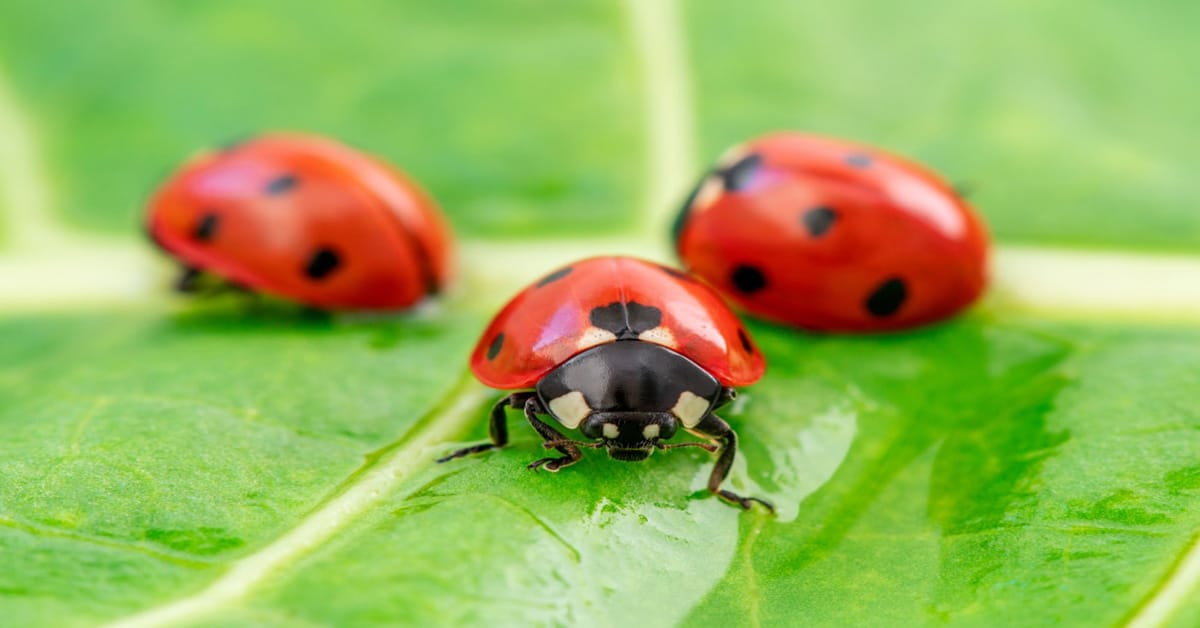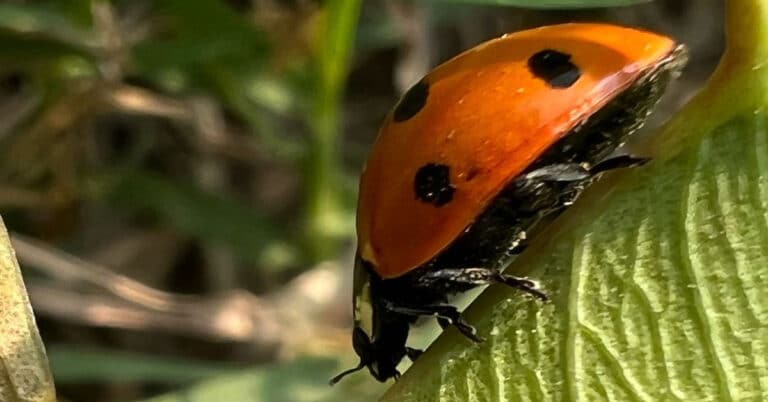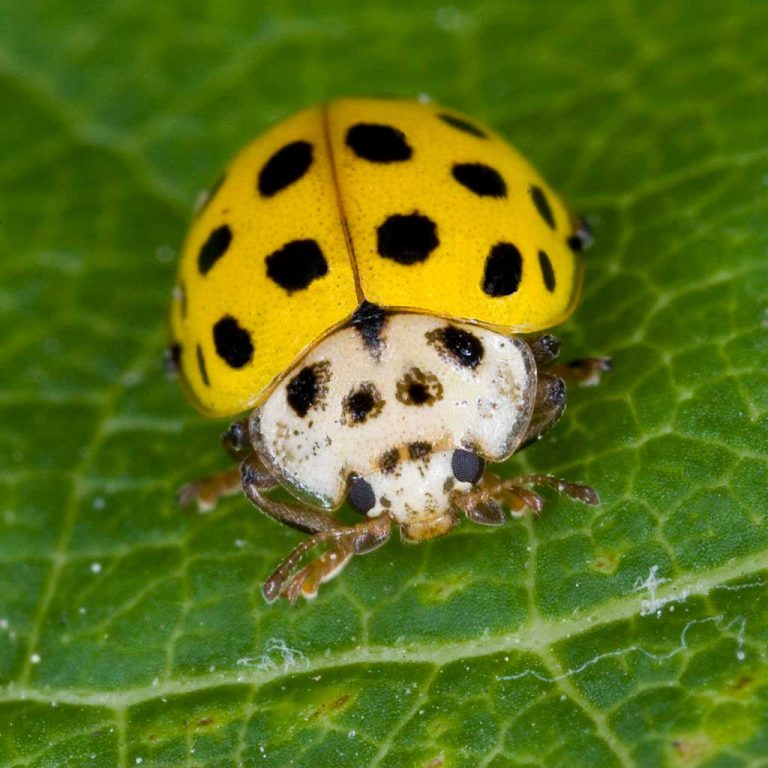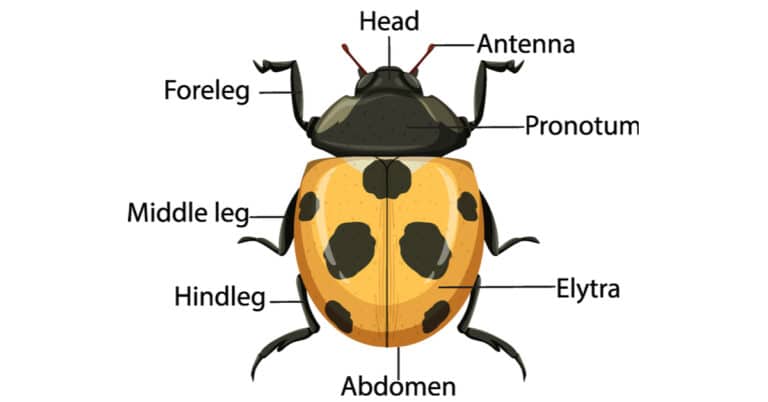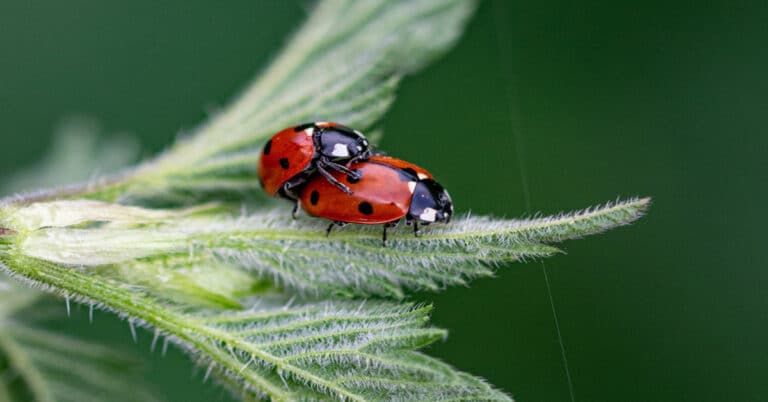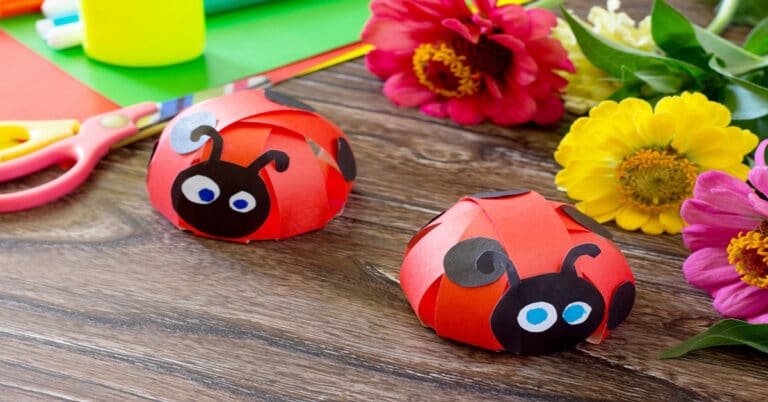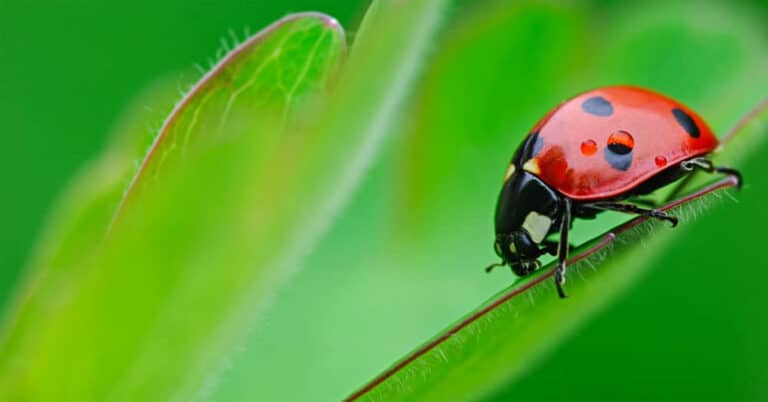Ladybug Facts
A Ladybird FAQ
What do ladybugs eat?
Are ladybugs poisonous?
No. Ladybugs are not poisonous to humans. However, they can have toxic effects on some animals. Ladybugs have a foul odor which deters some predators from eating them and their bright colors also help as a deterrent. In nature, red and orange, are warning colors that indicate to another animal or insect that the potential “lunch item” might not be a good choice.
Ladybug Infestation! LadyBugs are In my HOUSE! Why?
They have probably been hibernating under the sliding of the house or apartment and the warmer temperatures have caused them to emerge- it’s just that they are going in the wrong direction. You would think that they would be trying to get out of the house, but they are coming in. It happens. This happens because of the variation in temperatures from the interior of the home verses the outside temperatures. The ladybugs are merely confused. Visit the Ladybug Infestation page for more details.
Why do ladybugs come into my house in the winter time?
Ladybugs are attracted to the light colored houses. Especially, homes that have a clear southwestern sun exposure. Older homes tend to experience more problem with aggregations due to lack of adequate insulation. The ladybugs come in through small cracks around windows, door ways and under clap boards. They want to hibernate in a warm, comfortable spot over the cold months of winter. Ladybugs gather in groups when they hibernate, so if you see one, you can be sure more will follow. The best way to keep them out is to repair damaged clap boards, window and door trim and to caulk small cracks.
Once the ladybugs are in my house, will they eat anything?
No. Ladybugs don’t eat fabric, plants, paper or any other household items. They like to eat APHIDS. Aphids are very small, but very destructive pest that feed on plants. (If you have rose bushes, you have probably seen aphids.) Ladybugs, while trying to hibernate in your house, live off of their own body fats. They, also, prefer a little humidity. But our homes are usually not very humid during the winter. In fact, they are rather dry causing most of your ladybug guests to die from dehydration. Occasionally, you might witness a ladybug in your bathroom getting a drink of water. Now, that’s a smart lady!
How can I get them out of my house?
If you don’t have a lot, just leave them. They will leave when spring arrives. Disturbing them will only cause them to stress out leaving yellow markings on your walls. The yellow stuff, you see, is not waste matter, but rather, their blood. Ladybugs release a small amount of their blood which is yellow and smells, when they sense danger. Some people have said that it does stain on light colored surfaces.
But, I really want the ladybugs out of my house!
Use a “shop vacuum”. This type of vacuum is easy to use for collect ladybugs. When using this to vacuum up ladybugs, use a clean bag or pad the bottom with a cloth. After all is clean, release the unwelcome guests outside.
Is there anything else I can use to get the ladybugs out of my house?
Yes. There is a product called a Ladybug Black Light Trap. It uses radiating black light to attract and contain the ladybugs.
I have to write a science report on ladybugs. Can you give me more information about their life?
You have come to the right place! There is tons of information here at the www.ladybuglady.com web site. Let me show you where to go. First start here; you are on the Questions and Answers page. There is information about the spots, the predators, the things they eat and why the the Asian Ladybug comes into people’s houses. Next, you can go to the Science Fair Information page. This page has all the Scientific information about a ladybug called Hippodamia convergens. There is info about their wings, antennae, legs, reproduction and more. This particular ladybug is native to all of North America and parts of South America. Next, if you want to see pictures of ladybugs, well, they are all over the website! But you will find most of them here on the Pictures of Ladybugs and Larva page. If you need pictures of what the ladybug likes to eat, go to Garden Eaters. Remember, you can always click on the BACK button at the top of your screen to come back to this page after looking at one of the other pages. Thanks for coming to www.ladybuglady.com Your report is going to turn out great! Good Luck.�
We found ladybug eggs at our house. They hatched! What can we expect to see and how can we care for them, so that we can watch the life cycle?
Wow! This is a very exciting time at your house!!!! Depending on the species, and the temperatures, the ladybug larva can hatch out of the egg in 4-10 days. When the larva hatch out, they are so incredibly small, you will not want to move them or touch them. Depending on the species again, the first food of the larva is to eat the egg case that they just hatched out from.
After that anything is fair game, including the other larval siblings. You may also notice that the egg cases if left have turned white and dried out. After two days, bring aphids to the larva in the bug box, the smallest aphids possible. And often. Don’t add water quite yet. The larva could drown if over sprayed. They will get enough moisture from the aphids. After about four days, you will probably begin noticing the changing. They are growing and shedding the first of several skins. This process is called “in-star”. Because insects have an exoskeleton (outside skeleton), when the larva grow, they have to basically bust out of the exoskeleton to get bigger. The soft exoskeleton that is revealed dries and hardens, protecting the larva once more until it has grown too big on the inside once more. This happens about 5-7 times in the larval stage, depending on the species and the amount of food available. After about 10-14 days, the larva will affix itself the a stable structure to begin the metamorphosis, the process by which the larva of an insect completely transforms in appearance into the adult form of the species. This process can take 7-14 days depending on temperature, type of species, the amount of food eaten during the larval stage and humidity. In other words, a lot of varying factors. When the adult ladybug emerges from the pupa, it is in a very vulnerable state. The ladybug’s body is very soft and wet as the new exoskeleton still must dry and harden. The colors and spots look dull, but once it is dry the colors are bright and the ladybug will present the world with its new life.�You can even watch the entire life cycle with a�ladybug Rearing kit�where you get to watch the baby ladybug larvae grow and turn into adult ladybugs.
Do ladybugs build their own home?
No. Ladybugs reside where insect pest populations are high. Such as in crop fields, gardens, and in the canopies of trees.
How do ladybugs protect themselves?
Nature has uniquely designed a warning system of colors. Red, yellow and black are colors that warn predators that the insect they are about to eat might not be a good lunch choice. The colors can warn of danger such as poisonous, bad taste, or the ability to defend itself against the predators. Colors can also camouflage and warn when there is nothing about the insect that is harmful. Ladybugs can also protect themselves by playing dead. By pulling their legs up “turtle-style”, and typically release a small amount of blood from their legs. (This is called reflex bleeding.) The bad smell and the apparent look of death usually deter predators from their small ladybug snack. After the threat of danger has passed, the ladybug will resume its normal activities.
Can I keep a ladybug as a temporary pet?
Keeping a ladybug as a pet to observe will be fun. You can house your ladybug in a bug box or terrarium. Keep the foliage moist, or place a damp paper towel inside so the ladybug can get a drink. You can feed your ladybug moistened raisins or other sweet, non-acidic fruits. This will help maintain their fat reserves until you are ready to release the ladybug in spring. You can even watch the entire life cycle with a�ladybug Rearing kit�where you get to watch the baby ladybug larvae grow and turn into adult ladybugs.
What is the yellow stuff coming from the ladybug?
Ladybugs can excrete some of their blood as a defense, which is mentioned above. It is yellow and smells bad. There is that “color” defense again and it does smell quite unpleasant.
How did the ladybug get its name?
In Europe, during the Middle Ages, insects were destroying the crops, so the Catholic farmers prayed to the Virgin Mary for help. Soon the Ladybugs came, ate the plant-destroying pests and saved the crops! The farmers began calling the ladybugs “The Beetles of Our Lady”, and they eventually became known as “Lady Beetles”! The red wings represented the Virgin’s cloak and the black spots represented her joys and sorrows. They didn’t differentiate between males and females.
Are all ladybugs girls?
No. There are boy ladybugs and girl ladybugs. It’s almost impossible for the average person to tell them apart. But here are some clue that might help. First, females are usually larger than males. Second, if you observe one ladybug riding atop another ladybug, they are in the process of mating. A male ladybug will grab the female’s elytra (hard wings) and holds on tight. There are photos on the Ladybugs Mating Page to help you. An entomologist (bug scientist) can see the difference between males and females under a microscope.
What are boy ladybugs called?
Boy ladybugs are called ladybugs, too.
Can two different species mate to produce a new species?
Ladybugs are typically “species specific”. That means that they can only reproduce successfully with members of their same species. The male and female reproduction parts are termed “lock and key” which means that the male’s aedeagus (insect penis) will only “fit” with the female of his same species. New species evolves over time through a process called evolution. It can also occur more rapidly through genetic mutations that have continued to appear in successive generations.
What are ladybug babies called?
Ladybug babies are the larva. They look like little black and orange alligators with small spikes. You can see a picture on the Pictures of Ladybugs and Larva page.
Are there different kinds of ladybugs?
Yes. There are hundreds of different kinds all over the world. There are about 500
Are there different kinds of ladybugs?
Yes. There are hundreds of different kinds all over the world. There are about 500 different kinds in the United States and nearly 5000 world wide. They come in all different colors, too. Reds, yellows, orange, gray, black, brown and even pink.
What animals and insects prey upon the ladybug?
There are lots of animals and insects that prey upon ladybugs. Some insect-eating birds, like martins, swallows, swifts and crows. Insect-eating insects prey on ladybugs like dragonflies, assassin bugs, parasitic wasps, and ants. Other predators include tree frogs, anoles, parasites, fungus and mites. Ladybugs certainly have their shares of problems!
At the beginning of September, thousands of ladybugs were found in Lake Michigan. Why were they in and around the lake?
Periodically, all kinds of different insects can be found flowing in and around Lake Michigan. Although, during the early part of this month, the Lake Michigan area experienced some strong weather patterns. Insects can be carried on strong air currents created by storms, only to be “dropped off” somewhere else.
Do the spots tell you how old they are?
No. Different ladybugs have different numbers of spots. Some have no spots while some have as many as twenty four. Ladybugs generally complete their life cycle within one year. The spots are with them all their life. They don’t get more spots as they get older, nor do they lose spots.
Does the number of spots tell you what kind of ladybug it is?
Yes and No. An entomologist can use the spots as a guide in determining what kind of ladybug it is, but it is not the only piece of information gathered. For an average person the spots can greatly help, but the shape and coloration are going to be just as important. Some different types of ladybugs may have the same number of spots.
What are the life cycle stages of a ladybug?
Egg, Larva, Pupa, and Adult. The first three stages vary from 7-21 days each depending on the weather, and food supplies. The adult stage lasts between 3-9 months depending on weather, length of hibernation, food supplies and, of course, predators.
Why are ladybugs considered a “beneficial” insect?
Ladybugs feed on aphids and other soft bodied insects that feed on plants. The ladybug feeds on these pests as the adult ladybug and as the larva. One ladybug can eat as many as 50 aphids a day. Now, that’s a hungry lady! Visit the Ladybugs Helping Gardeners page for more info.
Even More Fun Facts:
- Because Ladybugs eat lots of aphids and other pest insects, many gardeners and farmers use them for pest control instead of chemicals.
- A Ladybug can lay up to 1000 eggs in its lifetime.Not all Ladybugs have spots.
- Ladybugs will clean themselves after a meal.
- Ladybugs come in many colors like pink, yellow, white, orange and black.
- Over 300 types of Ladybugs live in North America.
- Ladybugs make a chemical that smells and tastes bad so predators won’t eat them. Ladybugs hibernate in large groups in cold weather.
- Many countries consider a ladybug to be a sign of good luck.
- Ladybugs are actually beetles, so sometimes are called LadyBeetles.
- The bright colors of Ladybugs warn birds that they don’t taste good.The spots on a Ladybug fade as they get older.

Having discovered a fondness for insects while pursuing her degree in Biology, Randi Jones was quite bugged to know that people usually dismissed these little creatures as “creepy-crawlies”.

